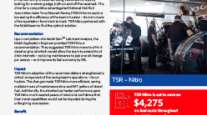Wholesale Diesel Price Spikes
By Jonathan S. Reiskin, Associate News Editor
This story appears in the Jan. 9 print edition of Transport Topics.
Wholesale diesel prices spiked last week as tensions in the Middle East rose and temperatures in the eastern United States fell, signaling the likely end of the current run of declining retail prices.
The U.S. retail diesel average declined for a sixth straight week, dipping 0.8 cent a gallon to $3.783, the U.S. Department of Energy said after its Jan. 2 survey of fueling stations. As recently as Nov. 21, the average stood at $4.01; a year ago, it was $3.331.
DOE also reported that gasoline rose 4.1 cents a gallon to $3.299, the second straight increase. A year ago the gas average was $3.07.
However, wholesale diesel prices — as measured by the New York Mercantile Exchange — shot up by 15.5 cents a gallon over the first two trading days of 2012 to about $3.09 a gallon. Over that same period, the average price at U.S. diesel racks leapt almost 16 cents to $3.20, according to a survey by Bloomberg News.
“We’ve seen wholesale diesel prices spike . . . higher in the first two business days of 2012,” said Tom Kloza, chief analyst of the Oil Price Information Service, Wall, N.J. “Some of it is tied to the crude oil surge [spurred by Iran’s threats to oil shipments], and some of it to the closure of key European refineries. A bit of it is tied to brisk exports and cold weather.
“It’s kind of easy to predict a little sticker shock [for diesel] in the next week,” Kloza added.
“We’re anticipating an increase of 20 cents a gallon,” said Barbara Cytlak, finance director of truckload carrier Garner Transportation Group, Findlay, Ohio. Cytlak’s comparison was for the pricing of bulk purchases on Jan. 2 and Jan. 6.
Most of Garner’s work in hauling consumer goods is done on a contractual basis, and Cytlak said Garner will not take on a customer without a fuel surcharge provision. However, there is still the problem of working capital, she said.
“This will put us in a cash crunch. We have seven to 10 days to pay for fuel,” she said, contrasting that with the 30 to 45 days that shippers take to pay off freight invoices. When fuel prices go on a long, steady rise, she said, the lag time means that “cash becomes tight.”
At T.E. Walrath Trucking, Tacoma, Wash., fuel costs are now more than 20% of the company’s budget, compared with 5% to 6% about 20 years ago, General Manager Tom Walrath Jr. said of his family’s business.
“Diesel is four times higher, but our rates have only doubled,” Walrath said.
Walrath said he was pleased with the recent “reprieve” on prices, but “deep down, to be realistic, I figured I’d just enjoy it while it lasted. It doesn’t surprise me that it didn’t stick.”
His company operates 24 dump trucks and moves sand, gravel, dirt and raw materials for construction in western Washington state. Because the construction industry is still depressed, Walrath said, his customers fight against fuel surcharges, and there often are competitors willing to haul for less than cost.
“When fuel prices go up, we’re at risk of losing business to competitors, who don’t understand their own pricing,” Walrath said.
Wholesale diesel prices follow escalation in the price of crude oil. The Nymex price closed the year at $98.83 a barrel but jumped past $103 by Jan. 4. Oil closed at $101.81 on Jan. 5.
The previous time crude closed higher was $103.88 on May 10.
The timing corresponds with increasing tension in the Persian Gulf between Iran and the United States over international economic sanctions aimed at Iran, which has threatened to shut down oil shipping through the Strait of Hormuz. The U.S. Navy has an aircraft carrier nearby and has pledged to keep oil flowing. Bloomberg News estimated that 20% of the world’s oil passes through the strait.
At the same time, the Institute for Supply Management said U.S. manufacturing rose to its highest level since June.
ISM’s monthly factory index rose to a reading of 53.9, from 52.7 in November, the group said Jan. 3. Figures more than 50 indicate expansion.
December marked the index’s 29th straight month of expansion.




